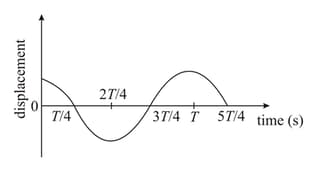MEDIUM
NEET
IMPORTANT
Earn 100
Identify the function which represents a periodic motion
(a)
(b)
(c)
(d)
81.65% studentsanswered this correctly

Questions featured in Previous Year Papers on Simple Harmonic Motion & Waves
MEDIUM
NEET
IMPORTANT
MEDIUM
NEET
IMPORTANT
HARD
NEET
IMPORTANT
HARD
NEET
IMPORTANT
HARD
NEET
IMPORTANT
Two identical coherent sound sources and with frequency are apart. An observer standing equidistant from the source and at a perpendicular distance of from the line hears maximum sound intensity.
When he moves parallel to , the sound intensity varies and is a minimum when he comes directly in front of one of the two sources. Then, a possible value of is close to (the speed of sound is )
HARD
NEET
IMPORTANT
MEDIUM
NEET
IMPORTANT
MEDIUM
NEET
IMPORTANT
The displacement time graph of a particle executing SHM is given in figure: (sketch is schematic and not to scale)

Which of the following statements is/are true for this motion?
(A) The force is zero at
(B) The magnitude of acceleration is maximum at
(C) The speed is maximum at
(D) The is equal to of the oscillation at
